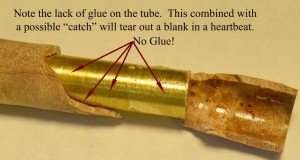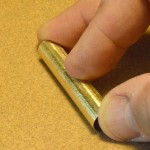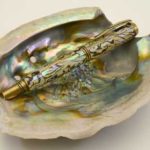
Distracting Background
I’ve served as a juror for high end craft shows for many years. One issue that always stands out is how people photograph their work. Some people have elaborate sets, props and backgrounds, and the piece that they are trying to photograph gets lost in the background. They feel that the “artsier” the image the better, when a plain image is sometimes better. I am no expert by any means, however, when you can see the work clearly then you are ahead of the game. Below you will find some general guidelines to help you obtain the image you want so your acceptance into a “Pen Contest” or a juried craft show gets easier for you.
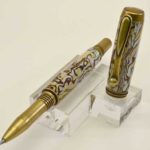
Clean Background & In Focus
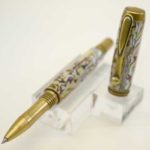
Out of Focus
First and foremost, make sure your piece is in focus! If you are using a digital SLR camera do not use the auto setting. Use the aperture setting (lens opening) on your camera and set it as high as you can (f16 or f22) to get the most depth of field (focus) as you can. This will assure your photo will be in focus from the front to the back. A tripod is helpful to hold your camera to steady the image. Please consult your camera’s manual for exactly how to use it manually.
Lighting is very important. A dark picture cannot show the detail in the work. Natural sunlight is best

Dark Image
but it can give you very harsh shadows. Use a light tent and light the image from three sides, (top, and left & right sides). By lighting from three sides, you soften any shadows you may get. The light cancels out the shadows. Using one source of light will usually produce harsh shadows.
Use a plain background. You want your pen to be the main focus not what you are using as a background. I personally like using a clear pen stand to photograph my pens. If you do not use a stand for your photograph, and you just lay it on your background, your pen will tend to roll and not lay the way you want it to. Use some tacky putty, museum wax or a tiny piece of scotch tape rolled up and stuck to the back of the pen. This will allow you to position the pen in the way you want.
Although a digital SLR will probably give the best results, you can still get very good results using a phone or tablet that have a good camera. There are many photography apps available that can help with aperture & focus. Do not use any built-in filters, they won’t make your photo any better. There are attachments for phones & tablets that will allow you to use a tripod to keep it steady for a sharp photo.
So, lighting, focus and a plain background will work most of the time especially, if you are trying to win a “Pen Contest” – get the hint! Good luck and happy picture taking!











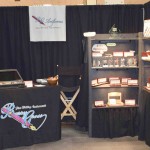 It is very important to display your items so your customers can see them clearly. Please, don’t just throw a drape over the table and open up a carry case with your pens in it! Put some thought into how you will display your work. You want to have your pens at eye level if possible. Have some sort of a step arrangement to place acrylic stands or pen boxes on the steps to elevate them off the table. It can be as simple as stacking some sturdy and attractive cardboard, wood or acrylic boxes to give you several levels of interest on your display. Local craft stores have many items that can be used for display purposes. Look at jewelry display trees for hanging up key rings, small styli, and other small colorful items for sale. These are just a few ideas to get you started for a successful show.
It is very important to display your items so your customers can see them clearly. Please, don’t just throw a drape over the table and open up a carry case with your pens in it! Put some thought into how you will display your work. You want to have your pens at eye level if possible. Have some sort of a step arrangement to place acrylic stands or pen boxes on the steps to elevate them off the table. It can be as simple as stacking some sturdy and attractive cardboard, wood or acrylic boxes to give you several levels of interest on your display. Local craft stores have many items that can be used for display purposes. Look at jewelry display trees for hanging up key rings, small styli, and other small colorful items for sale. These are just a few ideas to get you started for a successful show.

